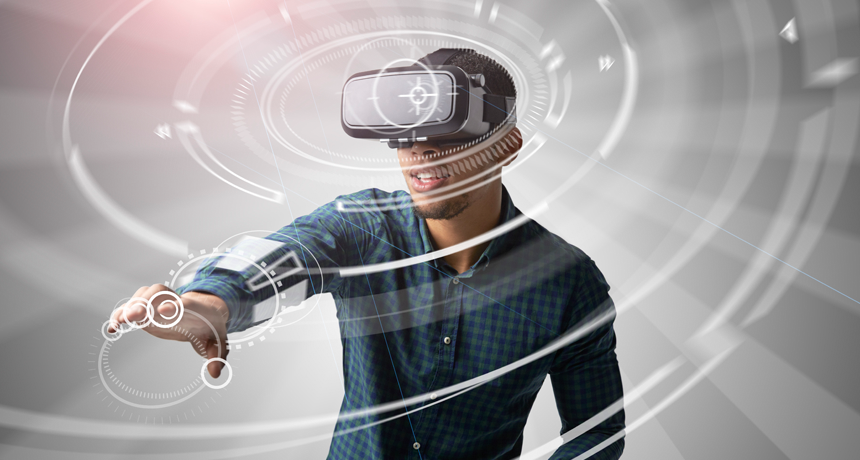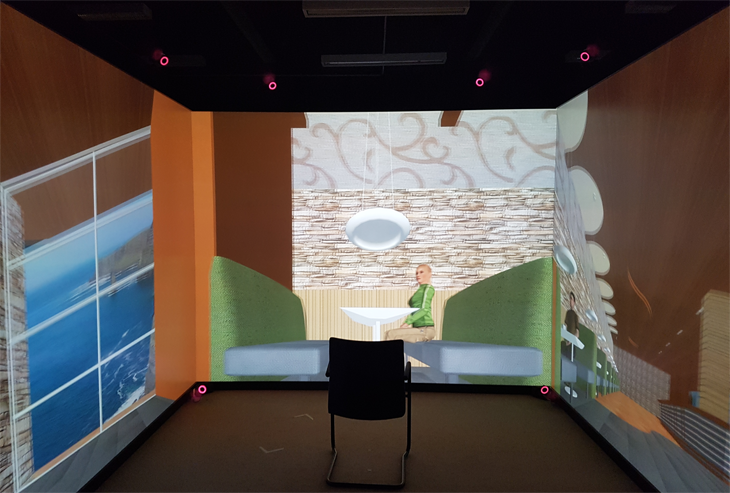
Strap on a virtual reality headset and you’ll enter a different world. Without leaving your house, you can fly a spaceship through a make-believe galaxy. You can play pool with friends. Or you can perform surgery on an alien.
Virtual reality, or VR, uses special technology to trick the brain into thinking these experiences are real. A technique called stereoscopy (STAIR-ee-OSS-kuh-pee) sends a slightly different image to each eye. This can create the illusion of depth. It certainly makes video games feel more realistic. But VR isn’t just for fun. It also can help scientists do their research or share it with others.
Scientists are using VR to learn more about people and the planet. One engineer uses this technology to let kids build mountains and carve out rivers with their bare hands. A scientist who studies language puts people in a virtual restaurant to learn what happens in their brains as they converse. A doctor takes patients on a virtual field trip to swim with dolphins. The worlds they visit are not real, but the science is.
Decoding dialogue
David Peeters loved learning foreign languages when he was growing up. His first language was Dutch. He studied three others at school — German, French and English.
In college and graduate school he focused on linguistics. It’s the science of human language. And the more he learned, the more Peeters began to wonder what happens inside our brains as people converse. He began to look at language through the lens of neuroscience — the study of the brain.
“There’s a lot about the way the brain processes speech that we don’t understand,” he says. Peeters is a scientist at the Max Planck Institute for Psycholinguistics in Nijmegen (Nih-MAY-jin), a city in the Netherlands. Peeters studies the way people communicate. To answer some of his questions, he built a virtual restaurant.
Real people stroll into it. To do this, they wear 3-D glasses. The small room they walk in has screens on every wall. It’s called a cave automatic virtual environment — CAVE for short. It’s basically a theater with a 3-D movie projected on every wall. To someone wearing 3-D glasses, it feels almost like a real world. (For people familiar with Star Trek: Next Generation, CAVEs are essentially a real-life version of the holodeck.)
Story continues below image.

The screens show scenes inside the virtual restaurant. Each person who takes part in the study “becomes” a waiter or waitress through an avatar. That avatar is a make-believe character. It can be moved around and used to talk to others in a virtual world. Participants move their avatar simply by walking around the CAVE.
Peeters wants to find out what happens in people’s brains as they speak with virtual restaurant customers through their avatar. He does this by having each person wear a cap covered in electrodes.
These small sensors on wires attach to the outside of the head. Cells in the brain communicate with each other by sending tiny zaps of electricity back and forth. Electrodes listen for these electrical impulses and then report them to a computer. The computer records this brain activity as a set of wavy lines called an EEG. That’s short for electroencephalogram (Ee-LEK-troh-en-SEFF-uh-low-gram).
Peeters uses the EEG data to see which parts of the brain are most active during a conversation. This gives him clues about how the brain processes or understands different patterns of speech.
For example, there are direct and indirect ways to say something. “Please bring me another soup” is a very direct way to communicate a need, Peeters points out. But a lot of our conversations are indirect. In the virtual restaurant, a customer may simply say, “My soup is cold.”
“We understand this means the customer wants another soup, even though they didn’t ask for it,” says Peeters. That’s indirect language.
Peeters studies the differences in brain activity when a person hears direct versus indirect speech patterns. He hopes such research will one day help scientists better understand disorders such as autism. That’s a condition in which people have a hard time processing speech and communicating.
A new way to relax
For many years, Wim Veling used VR to help patients overcome phobias, or fears. As a psychiatrist, he treats patients with mental-health disorders. Veling works at the University of Groningen in the Netherlands.
A person with a fear…
The post Cool Jobs: Doing real science in virtual worlds appeared first on FeedBox.